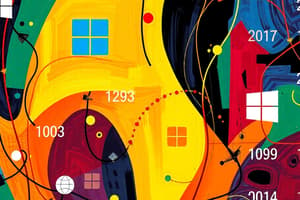Podcast
Questions and Answers
Please select all of the valid IP addresses. Check all that apply.
Please select all of the valid IP addresses. Check all that apply.
- 257.70.312.49
- 192.168.1.1 (correct)
- 123.456.123.456
- 8.8.8.8 (correct)
How many IP addresses does a class C network have?
How many IP addresses does a class C network have?
254
What does CIDR stand for?
What does CIDR stand for?
Classless Inter-Domain Routing
Which of the following is a correct form of CIDR notation?
Which of the following is a correct form of CIDR notation?
How many octets does a subnet mask have?
How many octets does a subnet mask have?
Select examples of routing protocols. Check all that apply.
Select examples of routing protocols. Check all that apply.
Who is permitted to use non-routable address space?
Who is permitted to use non-routable address space?
A typical routing table may contain which of the following? Check all that apply.
A typical routing table may contain which of the following? Check all that apply.
An ARP broadcast is sent to the special MAC address ________.
An ARP broadcast is sent to the special MAC address ________.
The process of taking a large network and splitting it up into many individual and smaller subnetworks is known as ________.
The process of taking a large network and splitting it up into many individual and smaller subnetworks is known as ________.
TTL stands for _______.
TTL stands for _______.
Ranges of IP addresses that anyone can use for their internal networks are known as ______.
Ranges of IP addresses that anyone can use for their internal networks are known as ______.
In binary, 1 + 1 = _____.
In binary, 1 + 1 = _____.
Calculate how many decimal numbers a 4-bit number can represent.
Calculate how many decimal numbers a 4-bit number can represent.
A router is performing basic routing functions. What will be the third step in the transmission of a packet?
A router is performing basic routing functions. What will be the third step in the transmission of a packet?
How many bits long is an IP address?
How many bits long is an IP address?
Which number cannot be represented by eight bits of data?
Which number cannot be represented by eight bits of data?
Which IP address is Class C?
Which IP address is Class C?
What protocol is used to discover the hardware address of a node with a certain IP address?
What protocol is used to discover the hardware address of a node with a certain IP address?
What is the process of taking a large network and splitting it up into many individual and smaller subnetworks called?
What is the process of taking a large network and splitting it up into many individual and smaller subnetworks called?
What is the maximum decimal number possible to represent with 16 bits?
What is the maximum decimal number possible to represent with 16 bits?
How many possible host IDs do you always lose per network?
How many possible host IDs do you always lose per network?
Which are a type of interior gateway protocol? Check all that apply.
Which are a type of interior gateway protocol? Check all that apply.
Flashcards are hidden until you start studying
Study Notes
Valid IP Addresses
- Valid IP addresses include 8.8.8.8 and 192.168.1.1.
- 123.456.123.456 and 257.70.312.49 are invalid due to exceeding octet limits.
Class C Network
- A Class C network can support 254 unique IP addresses.
CIDR (Classless Inter-Domain Routing)
- Stands for Classless Inter-Domain Routing.
- CIDR notation includes the IP address followed by a slash and the number of bits in the subnet mask, e.g., 192.168.1.0/24.
Subnet Mask
- Consists of 4 octets, matching the length of an IP address.
Routing Protocols
- Valid routing protocols include Border Gateway Protocol (BGP) and Routing Information Protocol (RIP).
Non-Routable Address Space
- Non-routable address space can be used by anyone for private internal networks.
Routing Tables
- Typical entries in a routing table include total hops and destination network.
ARP (Address Resolution Protocol)
- An ARP broadcast is sent to the MAC address FF:FF:FF:FF:FF:FF, requesting association with a specific IP address.
Subnetting
- Refers to dividing a large network into smaller subnetworks, allowing for better size management than traditional class systems.
TTL (Time to Live)
- A field in IP packets that prevents them from circulating indefinitely on the network by limiting their lifespan.
IP Addressing
- Non-routable address spaces are designated ranges of IP addresses available for internal network use.
Binary Arithmetic
- In binary, 1 + 1 equals 10.
Bit Representation
- A 4-bit number can represent 16 different values.
Router Packet Transmission
- The third step in a router's packet transmission is to look up the destination network in its routing table.
IP Address Length
- An IP address is composed of 32 bits and consists of four octets.
Decimal Representation Limits
- Eight bits can represent decimal numbers ranging from 0 to 255; 436 cannot be represented within this range.
Class C IP Address
- A Class C IP address has its first octet value ranging from 192 to 223; an example is 192.37.48.98.
MAC Address Discovery
- The ARP table facilitates the discovery of hardware addresses corresponding to specific IP addresses.
Maximum Decimal Representation
- The maximum decimal number representable with 16 bits is 65536.
Host IDs
- The number of usable host IDs is always reduced by 2 in any network; e.g., in a /24 network with 256 potential hosts, only 254 IPs are usable.
Interior Gateway Protocols (IGPs)
- Types include:
- Link State Routing Protocols: Advertise the state of each router's interfaces.
- Distance Vector Protocols: Share routing tables with neighboring routers, indicating the distance to known networks.
Studying That Suits You
Use AI to generate personalized quizzes and flashcards to suit your learning preferences.




